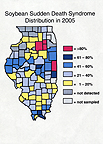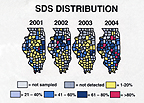November 01, 2005
Drought minimized impact of soybean SDS
CARBONDALE, Ill. -- While soybeans have rebounded dramatically from this year's summer-long drought, the hot, dry weather did produce one unmourned victim: soybean sudden death syndrome."Overall, we saw probably the least impact from SDS than any year in the last five," said Southern Illinois University Carbondale plant pathologist Jason P. Bond.
"Last year, we were estimating yield loss from SDS at around $100 million. This year, it was much lower than that."
Bond based his assessments on the annual "windshield survey," a drive-by inspection of a sampling of fields in virtually every Illinois county. SIUC teams check out the southern half of the state looking for SDS, while teams from the University of Illinois cover the north. The Illinois Soybean Checkoff Board has paid for the behind-the-wheel look-see since 1999.
As you might expect, the fungal disease suffered most in the north, the area hardest hit by the drought.
"There were some counties where we didn't see any foliar symptoms in the fields we sampled, and that mirrors the (dryness) pattern we saw with the drought," Bond said.
"The northwestern part of the state had very slight levels of the disease. In 11 counties where we normally see it, we couldn't find SDS in a single field."
Although the disease did better further south, it still lacked the punch of previous years.
"Normally, SDS incidence is really high in the central part of the state," Bond said.
"While this area still did have a higher incidence (than elsewhere in Illinois), it was nowhere near as severe as in previous years. It was more like it was in 2001."
Fields that did take a hit either were planted in early April or lay along river bottoms, Bond said.
Bond attributes the light showing to both weather and the fact that farmers increasingly are planting SDS-resistant beans.
"When you don't have good conditions for disease and you combine that with better-performing varieties, you drive down both the incidence and the severity," he said.
Further good news: the soybean rust fungus, widely expected to make an appearance in Illinois this year, never showed up. Sentinel plots set up throughout much of the state to alert researchers to its presence indicated that Illinois got through the summer spot-free.
Surprisingly, however, the teams did find evidence of another fungal disease.
"We saw a lot of frogeye leaf spot up in central and northern Illinois where we don't normally see it," Bond said.
"It can over-winter in this part of the state, but I think when Hurricane Dennis came through, it dumped a lot of spores — and not only here. The disease has turned up in parts of Ohio and Iowa, where they're not so familiar with the disease in terms of managing it."
The Illinois scouting team also found some brown stem rot in central Illinois, but again, nothing too worrisome.
"Compared to previous years, the impact of diseases on soybeans isn't going to be as severe because of the hot, dry conditions in the early part of the growing season," Bond said.
"There were some varieties that didn't do as well because of their maturity group and where they were in the growth stage when the drought hit. But the beans that hadn't started flowering yet caught the drought at the best time — prior to filling their pods.
"Considering all that we were looking at at the start of the season with Asian rust and the drought, things worked out pretty well for soybean production — you can't complain about the yields."
Leading in research, scholarly and creative activities is among the goals of Southern at 150: Building Excellence Through Commitment, the blueprint for the development of the University by the time it celebrates its 150th anniversary in 2019.


